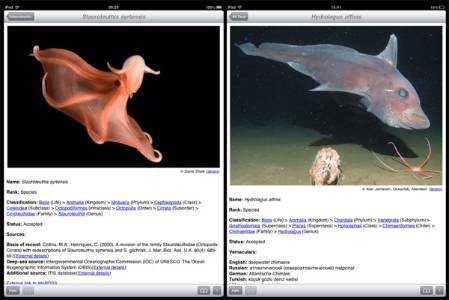 I am excited to announce the launch of Deep Sea ID, an app for the iPhone and iPad that provides taxonomic information on over 20,000 species, over 350 beautiful high resolution images of deep-sea specimens as well as links to online taxonomic tools, sources and important references. The app is completely free and I encourage interested users to download it here.
I am excited to announce the launch of Deep Sea ID, an app for the iPhone and iPad that provides taxonomic information on over 20,000 species, over 350 beautiful high resolution images of deep-sea specimens as well as links to online taxonomic tools, sources and important references. The app is completely free and I encourage interested users to download it here.
The deep sea is the largest yet least-explored ecosystem on the planet. Despite low temperatures, the absence of light and limited food availability, it is home to a remarkable diversity of marine life. Deep Sea ID is designed to enable faster access to important taxonomic information on these deep-sea animals and by including high quality specimen photos we are creating a field guide that can be used to identify specimens from collected samples or from video survey.
The app uses the species database at the World Register of Deep Sea Species (WoRDSS) which is itself a thematic database of the World Register of Marine Species (WoRMS), the most up-to-date source of taxonomic information on marine life. When we update Deep Sea ID, changes from the WoRDSS and WoRMS websites will be automatically included.
The images in the app have been individually sourced and include many beautiful specimen photographs from both researchers and professional photographers. All copyright images are used with permission from the authors, and contact details for the photographers are provided with all images.
One of the most important features of the app is that all the data and images are available offline, and at high speed. This allows it to be used by deep-sea researchers during their long voyages at sea where internet access is limited. We plan to regularly update the app with more images as they become available, and we welcome any potential contributors to contact the team at the WoRDSS, the database that the app is built around.
The creation of this app would not have been possible without our partner organisations, including the WoRMS, and the National Oceanography Centre in Southampton. Funding has come from the International Network for Scientific Investigation of Deep-Sea Ecosystems (INDEEP). We are also extremely grateful to all those who have contributed images so far.
The taxonomic information held in the WoRDSS is sourced directly from the WoRMS, which is managed by an international Steering Committee, a Board of Editors and the IT team at the Flanders Marine Institute (VLIZ) in Belgium. Both the WoRMS and WoRDSS websites are hosted at VLIZ.
The species lists and images that are used to create Deep Sea ID are currently maintained at the Museum by me, Dr Adrian Glover, and at the University of Plymouth, by Dr Nicholas Higgs. At the National Oceanography Centre, Dr Tammy Horton is contributing to the species lists and co-ordinating the collation of taxonomic identification resources.
This is an ongoing project, and we plan regular updates to the app. We welcome corrections and contributions for the next version and if you are able to help, please get in touch.



